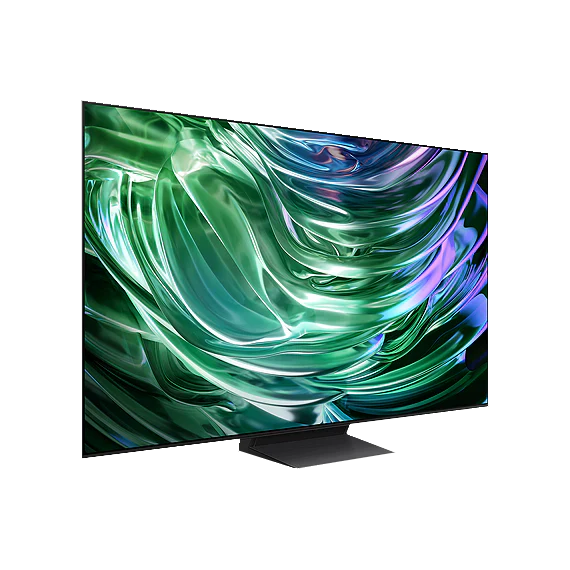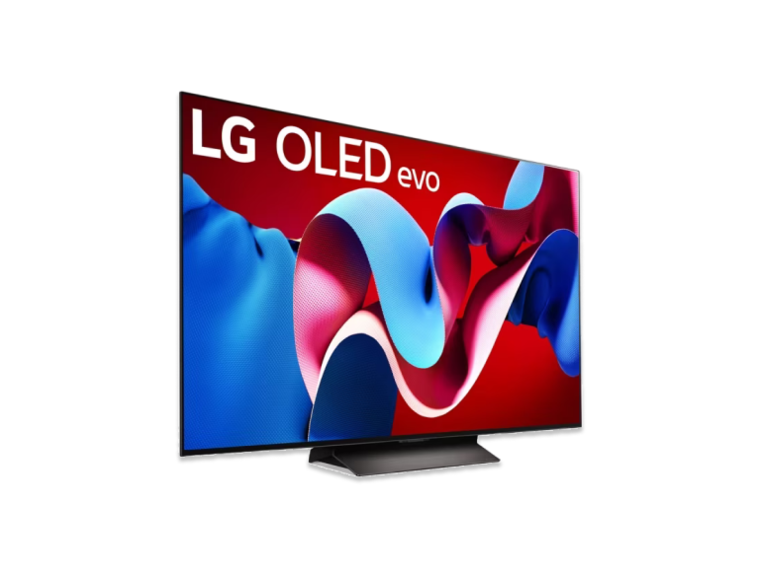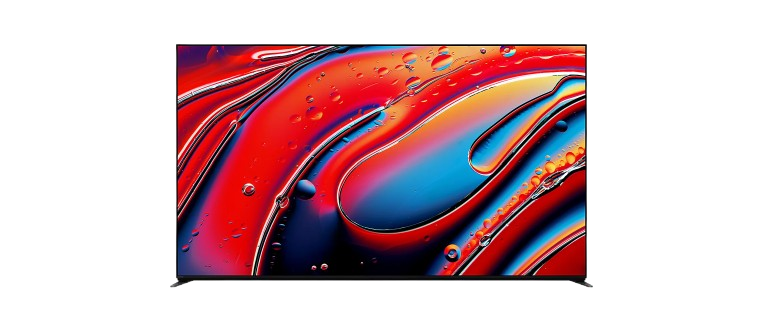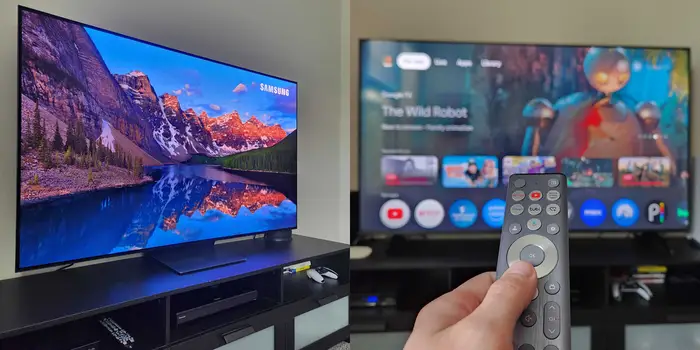TVs are an essential part of any home entertainment system. With a wide range of sizes, features, and prices, there is a TV to suit every budget and preference. From basic models with HD resolution to advanced 4K and OLED displays, TVs offer stunning picture quality and immersive sound. Smart TVs allow users to access streaming services and apps, while some models even feature voice control and built-in virtual assistants. With so many options available, finding the perfect TV for your home has never been easier.
INSIGNIA 32-inch Class F20 Series Smart HD 720p Fire TV with Alexa Voice Remote (NS-32F201NA23)
The INSIGNIA All-New 32-inch Class F20 Series Smart HD 720p Fire TV (NS-32F201NA23, 2022 Model) is a great choice for those looking for a lightweight and easy to move around smart TV. It has a 720p resolution, Alexa voice control, Fire TV experience built-in, supports Apple AirPlay, and supports HDMI ARC. It is a great starter TV for a child, and although it is small, it has good quality sound and lots of different apps to choose from.
What We Like
Fast delivery
Great picture quality
Easy setup
Affordable price
Smart TV features
What We Don’t Like
Stand placement
Quick timeout on pause
What Cusomers Say
“I had a flat-screen TV that died recently, and I’ve always used hand-me-downs. Finding this TV was a great relief! It has HDMI inputs, which is perfect for my broken laptop, and the price was fantastic. I was pleasantly surprised to find Vudu and various other apps available. The picture quality is clear, and I can actually see details in movies now. The only downside is the stand placement; it requires a stable table to support it properly.”
“I ordered this TV on December 23rd and it arrived in less than 24 hours. Setting it up was a breeze, and the price for a brand new unit was unbeatable. The picture quality is 720p, which is just right for my bedroom, and the remote works perfectly. I have no complaints at all about this purchase!”
“I got this TV for my kitchen because I needed something with good sound quality amidst all the noise. It’s been perfect! The picture is great, and I can control it with my Echo device, which is super handy when I’m cooking. I love the Fire TV features! Overall, I couldn’t be happier with this purchase.”
Table of Contents
- Samsung S90D OLED
- LG C4 OLED
- Sony BRAVIA 9 QLED
TOP 3 BEST TVS 2025
1 : Samsung S90D OLED

Here’s a rounded oue brightest 4K ever take on the Sony BRAVIA 9 QLED based on multiple expert reviews.
Tom’s Guide calls it “nearly on par with OLED but with better brightness praising its peak brightness and ATSC 3.0 tuner The Shortcut notes its stunning contrast-rich display and near-OLED-level black suppression, peaking around 2,816 nits.
Home Theater Review dubs it “the best Mini‑LED TV of 2024”, highlighting impressive brightness, contrast, and color accuracy delta E ~1.4 Wired (rating 9/10) mentions professional-grade color presets, Dolby Vision Bright mode, calibration modes for Netflix/Prime, and a strong 70 W speaker setup with upward-firing tweeters.
The Shortcut underscores built-in height channel Dolby Atmos sound, PS5-tailored gaming features like Auto HDR Tone Mapping and Multi‑View functionality What Hi‑Fi? praises outstanding local dimming and immersive built-in height effects ffers 4K @ 120 Hz, VRR, ALLM, and PS5 auto‑adaptive picture modes—but higher input lag (~10 ms) and only two HDMI 2.1 ports limit its appeal to hardcore gamers Tom’s Guide and SmartHomeSounds echo this.
ideal for average gaming setups, but there are faster TVs with more HDMI 2.1 support Still positioned as Sony’s flagship 4K Mini‑LED for cinephiles in 2025, with pricing easing to around same as Sony’s QD‑OLED Bravia 8 II Viewed as the best LED alternative to OLED: it outshines many others in bright-room performance and stays competitive on price vs top-tier OLEDs.
If your priority is stunning HDR picture quality, bright-room performance, reference-level cinematic playback, and immersive built-in sound, the Bravia 9 is one of the best LED TVs available today—especially with 2025 pricing adjustments. However, if you’re a competitive gamer, need more HDMI 2.1 ports, or wider viewing angles, some OLED models (e.g., LG C5/G5, Sony Bravia 8 II) may offer more complete packages for similar money Let me know.
if you want side-by-side comparisons, size/price breakdowns, or help finding the right size for your room!
Pros
- The TV’s anti-reflective coating helps reduce glare in well-lit rooms.
- Perfect blacks in a dark room with no blooming around bright highlights
- Incredibly wide viewing angle for a consistent image from the sides.
- Great reflection handling means it handles glare in a well-lit room
Cons
- In very bright scenes, there might be slight blooming around bright objects, which is a common issue with OLED TVs.
- The Tizen smart TV interface, while functional, can be slightly annoying or cumbersome for some users.
- As a high-end OLED TV, the S90D is likely to be more expensive than some other options on the market.
- Unlike some competitors, the S90D does not support Dolby Vision HDR or DTS audio formats
2 : LG C4 OLED

it “the best 65‑inch TV overall” for 2025, with peak brightness around 1,065 nits, vibrant HDR highlights, and inky‑black OLED contrast TechAdvisor measured peak HDR at 1,150 nits (10% window)—excellent for a mid‑range OLED, offering deep blacks and lush colors Four HDMI 2.1 ports, support for 4K @ 120–144 Hz, low input lag (~9–13 ms), VRR, G‑Sync, FreeSync, ALLM, Dolby Vision Game Mode and HGIG—all included from the top.
The Game Dashboard/Optimizer is highly praised: easy access to settings and performance stats without pausing gameplay Wired.
9/10, hails a9 Gen 7 chip’s AI upscaling and smooth menus, bright HDR, and an overall all-rounder appeal AI‑Tech Report, Best SpecPro, and Miracoup commend.
the combination of improved brightness, processor power, webOS 24, and gaming-centered features Wired also notes the OLED’s brightness now competes well in bright rooms—though side-view color shift remains typical of OLEDs Some see dimmer SDR/HDR content in Game Optimizer—others find it perfectly bright for night and daily use.
A few mention color/tint issues and pixel dithering, with partial fixes via calibration or firmware tweaks Side-angle color shifts are noted, though standard for OLED technology Built-in audio performs adequately, but pairing with
A soundbar is recommended Tom’s Guide points out that the C5 adds the Gen 8 Alpha 9 chip, slightly better brightness (SDR ~344 nits, HDR ~1,179 nits), and minor UI tweaks—but launch pricing remains the same For those deciding now, the C4 remains excellent value, but new buyers may prefer the C5’s marginally improved performance.
Pros
- Excellent overall image quality
- Preserves contrast well in bright rooms
- Superior contrast and off-angle viewing
- Wide variety of size offerings
Cons
- Expensive
- No major improvements over the C3
3 : Sony BRAVIA 9 QLED

Here’s a comprehensive view of the Samsung S90D RTINGS praises deep, ink-black OLED contrast, excellent HDR peak brightness (~1,193 nits for 10% window), wide viewing angles perfect blacks with no blooming HDTVs and More highlights vibrant color accuracy, wide gamut (100 % DCI‑P3), and strong SDR/ HDR performance that stands up well in moderately lit rooms Choose.
TV (AU/UK tests) report ~396 nits SDR brightness with good glare suppression—fine for daytime viewing, though a bit dim in extremely bright spaces RTINGS and Tom’s Guide give it top marks: near-instant pixel response, VRR, ALLM, FreeSync Premium Pro, up to 144 Hz, and ultra-low input lag—ideal for both PC and console gaming WIRED emphasizes gaming-focused features.
A Game Hub, game bar, and full 4 HDMI 2.1 support—all good for cloud and offline gameplay SamMobile (and Home Theater Insights) note the advanced NQ4 AI Gen2 processor.
Excellent real‑time upscaling and “Real Depth Enhancer” adds depth perception Tizen 2024 brings a refreshed interface, voice assistants (Bixby, Alexa), AirPlay, and cloud gaming options It includes a 40 W 2.1‑channel speaker setup with Dolby Atmos, Object Tracking Sound Lite, and Q‑Symphony support—solid, but a soundbar is recommended for full immersion Some users complain about the small, non‑backlit remote and occasional Tizen sluggishness No Dolby Vision—only HDR10, HDR10+, and HLG.
Some miss Dolby Vision’s dynamic metadata Auto Brightness Limiter (ABL) can dim large bright scenes during HDR playback Color accuracy quirks in Game Mode.
Reports of red tint or oversaturation when using HDR gaming modes—calibration needed Power board issues (“panel lottery”) mostly in larger QD-OLED sizes—some users report TVs dying suddenly.
Samsung has replaced boards under warranty, but quality control remains hit-or-miss Comparisons note slight blurriness versus LG C4 in sharpness tests, though this is contested
Pros
- Amazing HDR brightness for impactful highlights.
- Superb SDR brightness helps it overcome glare from indirect lighting.
- Exceptional upscaling and low-quality content smoothing.
- Colors are vibrant, lifelike, bright, and accurate
Cons
- Struggles with reflections from direct sources of light.
- Slow pixel transitions in Game Mode leads to blurry motion.
Factors to consider when choosing a TV
With all of the TVs available today, and all of the technical terms and jargon associated with television technology, it can be tough to figure out what’s important. Here’s a quick guide to help cut through the confusion.
Picture quality: Broadly speaking, the type of display technology helps dictate how good a TV’s picture quality is, but OLED is typically the best display technology, and this is followed by LCD (including QLED, and Mini LED). OLED tends to have the best picture quality because it doesn’t need a backlight and every pixel can be either on or off, leading to great black levels. In comparison, each LED in a backlight looks after multiple pixels at a time so it isn’t as precise — it’s not yet 1:1. Among midrange models, look for a feature including full-array local dimming, mini-LED and 120Hz refresh rate, which (unlike some other extras) do help improve the picture in my experience. Additionally, If a TV uses Quantum Dots it often leads to better color performance, whether it’s an OLED or an LCD.
Screen size: Bigger is better in my book. I recommend a size of at least 43 inches for a bedroom TV and at least 55 inches for a living room or main TV — and 65 inches or larger is best. More so than any “feature,” stepping up in TV screen size is the best use of your money. One of the most common post-TV-purchase complaints I’ve heard is from people who didn’t go big enough. And I rarely hear people complain that their TV is too large. It’s worth adding that while 4K resolution is sufficient for even the biggest models, and as they represent a poor comparative value.
Price: TVs range in price from $100 to more than $2,000. Smaller screens are cheaper, well-known brands are more expensive and spending more money can also get you better image quality. Most entry-level TVs have a good enough picture for most people, but TVs last a long time, so it might be worth spending more to get a better picture. It’s also best to shop for a TV in the fall when prices are lower.
Sound quality: Every TV has some sort of built-in speaker, but in my twenty years of reviewing AV equipment the sound of modern TVs has been routinely terrible. While I do test the audio on each model, if you are serious about sound quality then buying a (from $100) or home theater system will instantly improve vital aspects such as speech and bass reproduction.
Smart TV: Among entry-level TVs the most important feature is what kind of smart TV system the TV uses, and while some are proprietary to each brand (Samsung and LG) some models do offer Roku and Google TV.
For more TV buying advice check out How to Buy a TV
TV brightness according to CNET’s testing
One important aspect of image quality I test is overall brightness using the CS-2000 spectroradiometer. Here’s how brightness compares across select TVs listed above.
How much should I spend on a TV?
Prices vary widely by size and features, from less than $100 for basic 24-inch TVs to more than $2,000 for big OLED models. TVs last a long time, so we think it’s worthwhile to spend a little extra beyond the bare minimum to get a bigger screen, better picture quality or better features. With that in mind, here are some ballpark prices that will get you a very good TV in 2025.
- 55-inch: $700
- 65-inch: $1,000
- 75-inch: $1,300
You could pay (much) more or less. The fact is that just about any TV will produce a picture decent enough to satisfy most viewers. Most complaints you read in user reviews aren’t about picture quality. Instead, they’re about ease of use, smart TV menus or sound (or a broken TV).
What size TV should I buy?
In our opinion bigger is better, and your money is best spent on large screen sizes rather than a slight upgrade in image quality. The answer also depends on room size and seating distance If you have a big room and sit farther away, you’ll want a bigger TV.
What is the best smart TV system for streaming?
At CNET, our favorite is Roku for its simplicity, but different systems like Google TV, Amazon Fire TV, Samsung and LG have different strengths, particularly for voice commands. In any case, we don’t consider the built-in smart TV system that important because you can always connect a steaming device to any tv.
How do I get the best TV sound?
Most TVs sound terrible because their thin cabinets don’t have room for decent-size speakers or a bass. If you want to get good sound, you should buy an external audio system. Even an inexpensive soundbar will deliver much better audio quality than a TV’s built-in speakers.

